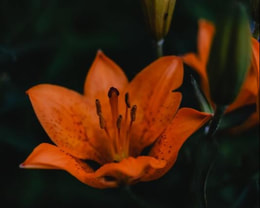 Tiger Lily - Photo by Eva Elijas, Pexels Tiger Lily - Photo by Eva Elijas, Pexels By The Mount Lehman Garden Club Most of us are familiar with Gladioli for summer colour, but there are many other summer bulbs that will give a real splash of colour in your garden. Some are hardy, but many have to be lifted in the fall and stored in a cool dry place until the last frost has passed. Many of them are cheap enough to replace every spring if you don't want to store them. The stars of the summer hardy bulbs are the lilies. There are many different varieties now, such as the Asiatic Lilies. They are short, and face upwards, with many blooms bunched at the top of the stem. They come in a myriad of colours, and there are now double ones. The new Patio Lilies are shorter, and do well in pots. The pots would need to be buried in the garden for the winter, otherwise the roots will freeze. There are also the Oriental Lilies. They are the tall ones - up to 6 feet with blooms opening in succession up the stem. They are usually very fragrant, and winter hardy. Tiger lilies are the old fashioned stars of the garden. They are tall, with spotted blooms with turned back petals that hang from the stems and open in succession. If they are happy where they are, they can have as many as fifty blooms on the stem, and the bulbs will multiply. Trumpet lilies are, as they sound, long trumpet shaped blooms, usually with incredible fragrance. The only thing you have to worry about is the fact that the pollen can stain fabric, so if they are brought indoors the stamens should be cut off to avoid the problem.
Other hardy summer blooming bulbs are Croscosmia (used to be called Montbretia), and Oxallis. Montbretia looks like a small Gladiolus, but the stem is arched and the orange, red or yellow blooms hang down. They bloom for a long time, and multiply readily. Oxallis looks like a shamrock. The leaves have three or four lobes and make a tidy mound about 9 inches high. They can be blue-green or burgundy red. The blooms are usually white or pink, and are flared trumpets. They are quite happy in the shade. The tender bulbs include Gladioli, with which we are all familiar, and begonias. Begonias do not have to be in pots or baskets. They are very happy in the ground and can light up a darker corner of the garden. A close relative of the Gladiolus is Acidanthera. The flower is almost orchid like, white with dark splotches and the centre of the flower. Canna lilies can lend a exotic look to the garden. They are a large tuber, and can be 6 feet high by the end of the summer. If started off in a pot underwater, they can be put into a pond when the weather warms up. They come in all shades of red and yellow and sometimes the foliage is spectacular. It can be red and green striped, yellow stripes or green and burgundy splashes. Dahlias are, strictly speaking, not bulbs, but tubers (like the potato), but can be treated as bulbs. They should be lifted in the fall, dried, then stored in peat or vermiculite in a cool, dry place. Don't put into plastic bags as they are likely to rot. Paper bags are fine. They can be separated to make more plants, but it is important that some of the stem is left on the tuber, as the new growth starts from where the stem joins the tuber. There are different kinds of Dahlias. The ones most useful are the bedding types. They grow to about 12" to 14" high and the same wide and are covered in blooms right up to the frost. They are mostly single or semi-double, and put on quite a show. Their big cousins are usually about 48" high and make a big plant. They can be decorative, cactus flowered, pom pom and other different shapes, but are all very free flowering. They may need staking if the weather is wet and/or windy. The largest ones are the dinner plate dahlias. The flowers can be up to a foot across, and definitely need staking. There are some small bulbs that can be used to fill the odd nook and cranny. Sparaxis come in a variety of bright colours. They are about a foot high with upward facing crocus like flowers, but many to a stem. Tigridias are just a little taller and have very exotic looking flowers. They face upwards, and have three large flat petals, with a well in the middle of the flower that is a darker colour with dark splotches. Ixias are a little taller, and also come in many different bright colours. The bulbs of all these plants need to be dug in the fall, but they are usually cheap enough that they can be treated like annuals and planted fresh each year. The last ones I want to mention are the Calla Lilies. These have the Arum Lily shape of a large funnel. They now come in many different colours, and some have variegated foliage. They are often sold as a pot plants, but can be put into the garden when the weather turns warm. There are many more summer flowering bulbs, but this selection should give colour for most of the summer. For more information and these and other gardening topics, join a garden club. All are welcome, and the more experienced gardeners are always willing to share their experience. The Mount Lehman Garden Club meets on the third Thursday of the month at the Mount Lehman Community Hall, 6418 Mount Lehman Road, at 7 pm. They do not meet is August or December. For more information please call Yvonne, at 604-856-0313
0 Comments
Your comment will be posted after it is approved.
Leave a Reply. |
Bradner Community NewsNews at your fingertips! Categories
All
Brought to you by...
The Barker Belongs to Bradner...Archives
July 2024
The Barker Belongs to Bradner...The Barker Belongs to Bradner... |























